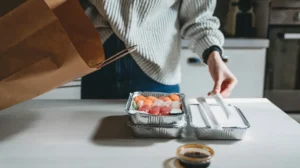No matter if you’re dining at a traditional sushi-ya or at home, employing proper dining etiquette can enhance the authenticity of your experience. Mentioning other chefs or shops is inappropriate while name dropping is generally unacceptable.
Respectfully avoid returning half-eaten pieces back onto your plate and don’t dip the rice side in soy sauce as this can cover up subtle flavors.
Set the Atmosphere
No matter if you are new to sushi making or looking to create an authentic experience at home, the first step in creating the ideal atmosphere for sushi making is creating the ideal environment in your kitchen. A clean and uncluttered environment with designated areas for dry ingredients such as rice and seaweed should be created; lazy susans or spice storage solutions may help organize them easily for easier access; furthermore a small sushi mat can add an authentic touch that enhances the experience.
Avoid wearing too much perfume or cologne; these scents can linger on food you are enjoying and diminish its flavor, as well as cause irritation among others who might be eating nearby.
Be considerate of the chef’s hard work. Too much soy sauce or wasabi can overwhelm delicate flavors carefully balanced by your chef, so only ask for additional soy sauce or wasabi if your chef specifically indicates otherwise. Respect their work by being respectful of their time and efforts!
Don’t Use Too Much Sauce
Too much sauce can destroy the delicate balance that chefs strive so hard to achieve, as too much sauce should complement rather than dominate the flavor of fish and rice dishes. Too much sauce also removes from its texture of rice dishes; sushi chefs recommend lightly dipping the fish side of your sushi roll or piece of nigiri into soy sauce so it can directly absorb all its flavors without acting as a sponge and diluting flavors in other areas of the meal.
Clean hands are key to an authentic sushi dining experience. A quality chef will often provide hot towels so that you can wipe your hands before and after each piece of sushi or sashimi is served, enabling you to use your fingers without worry that other foods could contain germs and bacteria that could potentially compromise its safety.
Don’t Leave Rice Behind
Leave behind rice after eating sushi is considered extremely rude and disrespectful of both the chef and their hard work. Furthermore, at sushi bars the chef may be nearby and see immediately if any part of your meal remains uneaten.
Soy sauce and wasabi should only be applied sparingly, as excessive use may obscure the delicate flavors of fish. Furthermore, each piece should be consumed immediately – leaving half eaten pieces behind is considered an insult to your chef!
Bear in mind that sushi chefs are accustomed to seeing newcomers at their sushi bars and understand that everyone experiences first-time anxiety at some point. Just try your best and be polite and respectful to ensure a successful experience – the Chefs appreciate when their patrons show appreciation for their hard work, which will encourage them to treat you more kindly while showing you more of their amazing creations!
Don’t Talk to the Itamae
At a sushi bar, it’s best to avoid engaging with the sushi chef (itamae) directly unless you have specific inquiries about something specific. Sushi chefs have much going on behind-the-scenes that may require their full attention; any unnecessary chatter will only serve to distract them further.
Ask your sushi chef for special items or advice, such as recommended rolls. But take care not to ask them directly whether an item is fresh as this could offend them as it implies that its quality may not meet standards.
Another excellent way to show your gratitude towards sushi chefs is by buying them drinks or sake if you are already on good terms with them and they have become familiar with your company. Just remember not to spend too long drinking as sushi should be enjoyed quickly before its temperature and texture change drastically if left sitting too long on its plate.
Don’t Drink Sake
Sake has been produced in Japan for millennia. There are strict rules regarding its consumption, from recommended temperatures for serving it and how to hold its flask (tokkuri), as well as when and how often one should consume it. Drinking sake should be treated seriously and is best enjoyed when enjoying sushi as part of an experience.
Assuming you prefer sake over sushi, green tea would make an excellent accompaniment. Although both foods contain grains such as rice, they do not complement each other well and thus it would be wiser to enjoy your sushi meal alongside green tea.
Sake can be an intoxicating drink, and controlling how much you consume may be tricky. Being aware of your consumption, especially when dining with others in a sushi bar setting is vital. One good strategy would be for one person at the table to serve all drinks to all diners simultaneously; that way no one will go thirsty while enjoying their sushi meal – plus this practice has hierarchical roots in Japan which makes for an overall better dining experience!


